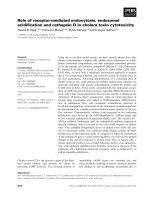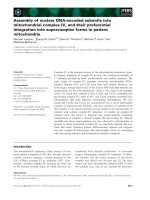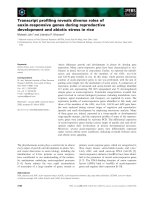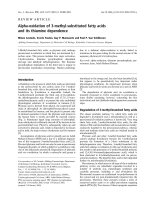Microbial conversion of vegetable oils into hydroxy fatty acids and their application in bio based polyurethane synthesis
Bạn đang xem bản rút gọn của tài liệu. Xem và tải ngay bản đầy đủ của tài liệu tại đây (2.36 MB, 146 trang )
工學博士學位論文
미생물을 이용한 식물성 오일의 하이드록시 지방산 전환
및 바이오 기반 폴리우레탄 합성 응용
Microbial Conversion of Vegetable Oils into Hydroxy Fatty Acids
and Their Application in Bio-based Polyurethane Synthesis
忠北大學校大學院
化學工學科 化學工學專攻
TRAN TUAN KIET
2019 年 08 月
工學博士學位論文
미생물을 이용한 식물성 오일의 하이드록시 지방산 전환
및 바이오 기반 폴리우레탄 합성 응용
Microbial Conversion of Vegetable Oils into Hydroxy Fatty Acids
and Their Application in Bio-based Polyurethane Synthesis
指導敎授
金 範 洙
化學工學科 化學工學專攻
TRAN TUAN KIET
이 論文을 工學博士學位論文으로 提出함
2019 年 08 月
A Dissertation for the Degree of Doctor of Philosophy
Microbial Conversion of Vegetable Oils into Hydroxy Fatty Acids
and Their Application in Bio-based Polyurethane Synthesis
Department of Chemical Engineering
Chungbuk National University
TRAN TUAN KIET
August 2019
Microbial Conversion of Vegetable Oils into Hydroxy Fatty Acids
and Their Application in Bio-based Polyurethane Synthesis
Advisor: Professor Kim, Beom Soo
By
Tran Tuan Kiet,
Department of Chemical Engineering,
Chungbuk National University,
Cheongju, South of Korea
A thesis submitted to the Chungbuk National
University in partial fulfillment of the requirements
for the degree of Doctor of Philosophy in the
department of Chemical Engineering
August 2019
本 論文을 TRAN TUAN KIET 의 工學博士學位 論文으로 認定함.
위 원 장
김대수 ㊞
부위원장
김범수 ㊞
위 원
신채호 ㊞
위 원
나병기 ㊞
위 원
문종호 ㊞
忠 北 大 學 校 大 學 院
2019 年 08 月
Contents
Contents..................................................................................................... I
Acknowledgements ................................................................................. VI
Abstract ................................................................................................. VII
List of Figures .......................................................................................... X
List of Tables ........................................................................................ XIV
Chapter 1: Introduction............................................................................ 1
1.1. Hydroxy fatty acids (HFAs) ................................................................. 1
1.1.1. Synthesis of HFAs ........................................................................ 1
1.1.2. Types of HFAs ............................................................................. 2
1.1.2.1. α-HFA and β-HFA ................................................................ 2
1.1.2.2. ω-HFAs ................................................................................. 3
1.1.2.3. Di-HFAs ............................................................................... 3
1.1.2.4. Tri-HFAs............................................................................... 4
1.1.3. Applications of HFAs ................................................................... 6
1.2. Pseudomonas aeruginosa PR3 and Pseudomonas aeruginosa KNU-2B
.......................................................................................................... 7
1.3. Polyurethane ...................................................................................... 10
1.3.1. Synthesis of Polyurethanes ......................................................... 12
1.3.2. Rigid polyurethane foams ........................................................... 16
1.3.3. Flexible polyurethane foams ....................................................... 16
1.3.4. Thermoplastic polyurethanes ...................................................... 17
I
1.4. Cell-free synthetic biology ................................................................. 17
1.4.1. Cell-free protein engineering....................................................... 20
1.4.2. Cell-free metabolic engineering .................................................. 20
1.4.3. Artificial cell engineering ........................................................... 21
1.5. Aims and objectives of this study ....................................................... 22
Chapter 2: Microbial Conversion of Vegetable Oil to 7,10-dihydroxy8(E)-octadecenoic acid and Its Application to Bio-Based Polyurethane
Synthesis .................................................................................................. 24
2.1. Introduction........................................................................................ 24
2.2. Materials and Methods ....................................................................... 27
2.2.1. Materials ..................................................................................... 27
2.2.2. Media and Cultivation Conditions ............................................... 27
2.2.3. Production of DOD from Olive Oil ............................................. 27
2.2.4. Preparation of PUs Based on DOD ............................................. 28
2.2.5. Preparation of PUs Based on DOD and PEG or PCLDO ............. 28
2.2.6. Analytical Methods ..................................................................... 29
2.2.6.1. GC/MS ................................................................................ 29
2.2.6.2. FTIR ................................................................................... 30
2.2.6.3. DSC and TGA ..................................................................... 30
2.2.6.4. Tensile Properties ................................................................ 31
2.3. Results and Discussion ....................................................................... 31
2.3.1. Production of DOD from Olive Oil ............................................. 31
II
2.3.2. Synthesis of PUs from DOD (PU-DOD) ..................................... 33
2.3.3. Synthesis of PUs from DOD and PEG or PCLDO (PU‐DOD/PEG or
PU-DOD/PCLDO) .................................................................................... 44
2.4. Conclusions........................................................................................ 49
Chapter 3: Microbial Conversion of Castor Oil to 7,10,12-trihydroxy8(E)-octadecenoic acid and Its Application to Bio-Based Polyurethane
Synthesis .................................................................................................. 53
3.1. Introduction........................................................................................ 53
3.2. Materials and Methods ....................................................................... 56
3.2.1. Materials .................................................................................... .56
3.2.2. Media and cultivation conditions ................................................ 57
3.2.3. Production of TOD from castor oil .............................................. 57
3.2.4. Preparation of PUs from TOD..................................................... 57
3.2.5. Preparation of blended PUs: PU-TOD/PEG and PU-TOD/PCLDO
........................................................................................................ 58
3.2.6. Characterization .......................................................................... 58
3.2.6.1. GC/MS ................................................................................ 58
3.2.6.2. NMR and FTIR ................................................................... 59
3.2.6.3. DSC and TGA ..................................................................... 59
3.2.6.4. Gel contents ........................................................................ 60
3.2.6.5. Tensile properties ................................................................ 60
3.3. Results and discussion ........................................................................ 61
III
3.3.1. Production of TOD from castor oil .............................................. 63
3.3.2. Synthesis of PUs from TOD (PU-TOD) ...................................... 68
3.3.3. Synthesis of PUs from TOD and its blend (PU-TOD/PEG or PUTOD/PCLDO) .......................................................................................... 78
3.4. Conclusions........................................................................................ 84
Chapter 4: Production of 7,10-dihydroxy-8(E)-octadecenoic acid from
Oleic Acid by Using Cell-free Synthesis Method ................................... 87
4.1. Introduction........................................................................................ 87
4.2. Materials and methods........................................................................ 89
4.2.1. Materials ..................................................................................... 89
4.2.2. Media and cultivation conditions ................................................ 89
4.2.3. DOD production by cell-free method .......................................... 90
4.2.4. Analysis of products ................................................................... 90
4.3. Results and Discussion ....................................................................... 91
4.3.1. Identify the structure of product .................................................. 91
4.3.2. DOD production by cell-free method .......................................... 92
4.3.3. Optimum condition for DOD production from oleic acid by cell-free
method ...................................................................................................... 97
4.3.3.1. Effect of pre-culture time..................................................... 97
4.3.3.2. Effect of carbon sources ...................................................... 99
4.3.3.3. Effect of nitrogen sources .................................................... 99
4.3.3.4. Effect of oleic acid concentration ...................................... 103
IV
4.3.3.5. Effect of initial pH and incubation temperature.................. 103
4.3.4. Discussion ................................................................................ 104
4.4. Conclusions...................................................................................... 109
Chapter 5: Conclusions and Future Prospects .................................... 110
Publications ........................................................................................... 112
References ............................................................................................. 113
V
Acknowledgements
I would like to express my sincere thanks and deepest respect to my
supervisor Prof. Dr. Kim Beom Soo. Thank you for your instruction, guidance,
support and encouragement throughout the duration of this study. Without your
help, I would not be able to complete my research.
I would like to thank Dr. Prasun Kumar and all the members of the
Biochemical Engineering Lab for helping me a lot in my research and making
my time in the lab more interesting.
I would also like to thank my friends at Chungbuk National University
for sharing unforgettable memories during my time in Korea.
Finally, I would like to express my sincere thanks to my family. Thanks
for always loving, caring, supporting and cheering for me. The love of family
is a great motivation to help me overcome all difficulties in life.
Thank you very much.
VI
Microbial Conversion of Vegetable Oils into Hydroxy Fatty Acids
and Their Application in Bio-based Polyurethane Synthesis
Tran Tuan Kiet
Department of Chemical Engineering
Chungbuk National University
Cheongju, South of Korea
Supervised by: Professor Kim, Beom Soo
Abstract
New polyurethanes were synthesized based on dihydroxy fatty acid
obtained by the microbial conversion of olive oil. Monounsaturated 7,10‐
dihydroxy‐8(E)‐octadecenoic acid (DOD) was produced from olive oil by
Pseudomonas aeruginosa KNU-2B and reacted with hexamethylene
diisocyanate (HMDI) at different ratios to form polyurethanes. Fourier
transform infrared spectroscopy and gas chromatography/mass spectrometry
confirmed the synthesis of DOD. The thermal and tensile properties of the
polyurethanes were investigated by differential scanning calorimetry,
thermogravimetric analysis, and a universal testing machine. At an
isocyanate/hydroxyl ratio of 1.4, the polyurethane exhibited an elongation at
break of 59.2% and a high tensile strength of 37.9 MPa. DOD was also mixed
VII
with polycaprolactone diol or polyethylene glycol at different weight ratios and
then reacted with HMDI to produce new polyurethanes of various properties.
These polyurethanes displayed higher elongation at break and good thermal
stability. This is the first report on the synthesis of polyurethanes based on
DOD produced by the microbial conversion of vegetable oil.
Castor oil is a vegetable oil containing 85-95% ricinoleic acid, a
substrate for tri-hydroxy fatty acids production. In this study, castor oil was
used as a raw material to synthesize 7,10,12-trihydroxy-8(E)-octadecenoic
acid (TOD) by the strain Pseudomonas aeruginosa KNU-2B. Subsequently,
HMDI was used in different ratios and reacted with TOD to produce new
polyurethanes. Fourier transform-infrared spectroscopy, nuclear magnetic
resonance spectroscopy, and gas chromatography/mass spectrometry were
used to confirm the identity of TOD. Differential scanning calorimetry,
thermo-gravimetric analysis, and tensile property testing were used to
investigate the thermal and mechanical properties of polyurethanes.
Polyurethanes synthesized based on TOD had a tensile strength of 45.4 MPa
with low elongation at break of 8.16% at an isocyanate/hydroxyl ratio of 2.0.
To modify properties of polyurethane, TOD was blended separately with
polyethylene glycol or polycaprolactone diol at different weight ratios before
reacting with HMDI. The modified polymer showed improved thermal
stability and comparatively higher elongation at break. This is the first study
VIII
demonstrating the conversion of castor oil into TOD that can be used stand
alone or as a blend for polyurethane synthesis.
Pseudomonas aeruginosa KNU-2B is a new strain isolated from
Pseudomonas aeruginosa PR3. This new strain was also capable of producing
7,10‐dihydroxy‐8(E)‐octadecenoic acid (DOD) from oleic acid but the
production yield was lower than by PR3. Cell-free synthesis method is known
for many advantages such as fast production rate, high product content. In this
study, for the first time, cell-free synthesis method was applied to DOD
production from oleic acid by strain KNU-2B to improve this process. The
results showed faster production time and higher product concentration than
conventional method. The production of DOD from oleic acid reached the
highest of 6.41 g/L of DOD in 36 hours. Various factors were changed to find
the optimal conditions for production. Among the carbon sources tested,
galactose was most effective for DOD production. Sodium glutamate and
diammonium phosphate were most effective for DOD production as using for
sole nitrogen source. The optimal pH and incubation temperature were 8 and
27oC, respectively.
IX
List of Figures
Figure 1.1. Biosynthetic pathway of oleic acid to 7,10-dihydroxy-8(E)octadecenoic acid ....................................................................................... 5
Figure 1.2. Application of Polyurethanes .................................................. 11
Figure 1.3. The chemical reaction of Polyurethanes (A) and their
classification (B) ....................................................................................... 13
Figure 1.4. Commercial diisocyanate........................................................ 14
Figure 1.5. Types of polyol ...................................................................... 15
Figure 1.6. Engineering protein, metabolism and artificial cell in the open
cell-free system ......................................................................................... 19
Figure 2.1. FTIR spectra of the product produced from olive oil by P.
aeruginosa KNU-2B ................................................................................. 34
Figure 2.2. EI mass spectra of the major product produced from olive oil by
P. aeruginosa KNU-2B. ............................................................................ 35
Figure 2.3. FTIR spectra of polyurethane‐7,10‐dihydroxy‐8(E)‐octadecenoic
acid (PU-DOD) with different NCO/OH ratios. ......................................... 38
Figure 2.4. Differential scanning calorimetry (DSC) analysis of PU‐DOD
with different NCO/OH ratios. .................................................................. 39
Figure 2.5. (a) TGA and (b) derivative thermogravimetry (DTG)
thermograms of PU-DOD with different NCO/OH ratios .......................... 40
Figure 2.6. Stress-strain curves of PU‐DOD with different NCO/OH ratios
................................................................................................................. 43
X
Figure 2.7. Reaction schemes for the synthesis of PU‐DOD/PCLDO and PU‐
DOD/PEG................................................................................................. 45
Figure 2.8. FTIR spectra of (a) PU-DOD/PEG200, (b) PU-DOD/PEG20K, and
(c) PU-DOD/PCLDO ................................................................................ 46
Figure 2.9. TGA and derivative thermogravimetry (DTG) thermograms of (a)
PU-DOD/PEG200, (b) PU-DOD/PEG20K, and (c) PU-DOD/PCLDO. ..... 50
Figure 2.10. Tensile properties of (a) PU-DOD/PEG200, (b) PUDOD/PEG20K, and (c) PU-DOD/PCLDO. ............................................... 51
Figure 3.1. Bio-conversion of castor oil to TOD by P. aeruginosa KNU-2B
................................................................................................................. 62
Figure 3.2. FTIR spectra of the major product produced from castor oil by P.
aeruginosa KNU-2B ................................................................................. 64
Figure 3.3. GC/MS of the major product produced from castor oil by P.
aeruginosa KNU-2B ................................................................................. 65
Figure 3.4. 1H-NMR spectra of product produced from castor oil by P.
aeruginosa KNU-2B ................................................................................. 67
Figure 3.5. FTIR spectra of PU-TOD with different NCO/OH ratios and PUCO ............................................................................................................ 71
Figure 3.6. DSC analysis of PU-TOD with different NCO/OH ratios ....... 72
Figure 3.7. (a) TGA and (b) derivative thermogravimetry (DTG) thermograms
of PU-TOD with different NCO/OH ratios ................................................ 74
XI
Figure 3.8. Tensile properties of PU-TOD with different NCO/OH ratios and
PU-CO ...................................................................................................... 76
Figure 3.9. Reaction scheme for the synthesis of PU-TOD, PU-TOD/PCLDO
and PU-TOD/PEG .................................................................................... 80
Figure 3.10. FTIR spectra of PU-TOD/PEG200, PU-TOD/PEG20K, and PUTOD/PCLDO ............................................................................................ 81
Figure 3.11. TGA and derivative thermogravimetry (DTG) thermograms of (a)
PU-TOD/PEG200, (b) PU-TOD/PEG20K, and (c) PU-TOD/PCLDO
................................................................................................................. 82
Figure 3.12. Tensile properties of (a) PU-TOD/PEG200, (b) PUTOD/PEG20K, and (c) PU-TOD/PCLDO. ................................................ 85
Figure 4.1. EI mass spectra of the major product produced from oleic acid by
cell-free method ........................................................................................ 94
Figure 4.2. 1H-NMR spectra of product produced from oleic acid by cell-free
method ...................................................................................................... 95
Figure 4.3. Comparison of DOD production from oleic acid between
conventional method and cell-free method ................................................ 96
Figure 4.4. Effect of pre-culture time on DOD production from oleic acid ....
................................................................................................................. 98
Figure 4.5. Effect of carbon source on DOD production from oleic acid .......
............................................................................................................... 100
XII
Figure 4.6. Effect of organic nitrogen source on DOD production from oleic
acid ......................................................................................................... 101
Figure 4.7. Effect of inorganic nitrogen source on DOD production from oleic
acid ......................................................................................................... 102
Figure 4.8. Effect of substrate concentration on DOD production from oleic
acid ......................................................................................................... 105
Figure 4.9. Effect of initial pH on DOD production from oleic acid ........ 106
Figure 4.10. Effect of incubation temperature on DOD production from oleic
acid ......................................................................................................... 107
XIII
List of Tables
Table 1.1. Production of DOD and TOD from fatty acid and vegetable oil by
P. aeruginosa KNU-2B ............................................................................... 9
Table 2.1. Thermal and mechanical properties of PU‐DOD. ..................... 41
Table 2.2. Thermal and mechanical properties of PUs from DOD with PEG or
PCLDO. .................................................................................................... 52
Table 3.1. Gel content of PU-TOD, PU-TOD/PEG and PU-TOD/PCLDO....
................................................................................................................. 70
Table 3.2. Thermal and mechanical properties of PU-TOD....................... 77
Table 3.3. Thermal and mechanical properties of PU-TOD/PEG and PUTOD/PCLDO ............................................................................................ 86
XIV
Chapter 1:
Introduction
1.1. Hydroxy fatty acids (HFAs)
HFAs are saturated or unsaturated fatty acids with a branchless long
carbon chain containing one or more hydroxyl (-OH) groups and a carbonyl (COOH) group at the end of the circuit. In nature, HFAs are found in waxes,
cerebellum, and lipids of animals, plants and microorganisms. Compared with
normal fatty acids, HFAs have higher stability, viscosity, reactivity and
solubility with solvents.
1.1.1. Synthesis of HFAs
Although
possessing
outstanding
properties,
HFAs
are
not
commercially available because of their high cost and their synthetic pathways
are not environmentally friendly. The chemical synthesis pathway of HFAs has
many limitations: multiple steps, poor selectivity, harsh reaction conditions,
toxic chemicals and low product diversity [1]. These factors have created
barriers to the potential of commercialization of HFAs. However, the
emergence of microorganisms capable of synthesizing HFAs has created a new
step in improving the value of these fatty acids. These strains are reported to
synthesize HFAs through the conversion of fatty acids or vegetable oils with a
variety of different enzymes. In general, there are four enzymes involved in
the conversion of fatty acids into HFAs: hydratase, cytochrome P450
1
monooxygenase, lipoxygenase, and hydroxylase [2]. Many studies have shown
that
different
enzymes
metabolize
different
HFAs
such
as
13-
hydroxyoctadecadienoic acid (HODE), 10-hydroxystearic acid and ω-hydroxy
fatty acid produced by lipoxygenase [3], hydratase [4] and cytochrome P450
monooxygenase (P450) [5], respectively. Compared to chemical synthesis, the
production of HFAs through microbial processes is easier, does not affect the
environment, and reduces production costs.
1.1.2. Types of HFAs
1.1.2.1. α-HFA and β-HFA
α-HFA and β-HFA are fatty acids that possess a hydroxyl group near
carboxyl group. These two HFAs are important for bacterial endotoxins, yeast
and fungi [6]. In addition, these fatty acids also possess antimicrobial activity
and work as part of the ring structure in some peptide antibiotics [7]. α-HFA
and β-HFA are synthesized through hydroxylation of fatty acids with the
support of the enzyme α-hydroxylases. The product of this process is usually
2-hydroxy and (or) 3-hydroxy fatty acids. Matsunaga et al. conducted the
conversion of myristic acid to hydroxymyristic acids with this enzyme in
Bacillus subtilis. The results obtained were a mixture of two HFAs, α- and βhydroxymyristic acids, with higher content of β-hydroxylated product [8].
However, when using α-hydroxylases from Sphingomonas paucimobilis,
hydroxylation only occurs at α-position of fatty acids [9].
2
1.1.2.2. ω-HFAs
ω-Hydroxy fatty acids (ω-HFAs) are long chain fatty acids containing
one -OH group at the position near the end of the circuit. ω-HFAs are often
used as monomer for the synthesis of polymer materials because they possess
the longest chain of carbon chains [10]. These fatty acids are also used to
prepare α,ω-dicarboxylic acids and ω-amino carboxylic acids which are used
as initial materials for the synthesis of polyamides and polyesters [11]. In
addition, ω-HFAs are used as intermediates in food, chemical and
pharmaceutical [12]. Fatty acids are converted into ω-HFAs under the catalytic
action of cytochrome P450 monooxygenases. P450 is a large and diverse
enzyme family with a multitude of enzymes whose activity targets fatty acid
objects. These enzymes are found in many microorganisms and enzymes used
for ω-hydroxylation of fatty acids present in Bacillus species such as Bacillus
subtilis, Bacillus megaterium [13], Bacillus cereus and Bacillus anthracis [14].
1.1.2.3. Di-HFAs
These HFAs contain two hydroxyl groups in carbon chains.
Representing these HFAs is 7,10-dihydroxy-8(E)-octadecenoic acid, also
known as DOD. This acid is produced from oleic acid by Pseudomonas sp.
PR3 in 1991 [15]. Subsequently, triolein, oilve oil and safflower oil were also
used as substrates for DOD production [16–18]. DOD is capable of reducing
surface tension and antibacterial activity. In addition, with the ownership of
3
two hydroxyl groups, DOD has great potential in polymer synthesis, especially
polyurethane. The hydroxylation occurs at C7 and C10 of oleic acid made by
enzymes belonging to the P450 family (Figure 1.1). The study of Kim et al.
[19] explained that the oleic acid hydroxylation took place first at C10 and the
double bond was relocated from C9-C10 to C8-C9. Hydroxylation takes place
at C7 followed immediately by the enzyme P450 and oleic acid completely
converted into DOD. Thus, the cytochrome P450 monooxygenases enzyme
plays an important role in supporting the production of DOD.
1.1.2.4. Tri-HFAs
As the name suggests, tri-HFAs contain three hydroxyl groups in the
molecular structure. Several tri-HFAs have been produced by microorganisms
from different fatty acids: P. aeruginosa PR3 converted 7,10,12-trihydroxy8(E)-octadecenoic acid from ricinoleic acid [20]; 9,10,13-THOD and 9,12,13THOD from linoleic acid [21] or 12,13,17-trihydroxy-9(Z)-octadecenoic acid
produced from linoleic acid by B. megaterium ALA2 [22]. In addition,
enzymes for the hydroxylation form tri-HFAs supposedly P450 oxygenase.
4
Figure 1.1. Biosynthetic pathway of oleic acid to 7,10-dihydroxy-8(E)octadecenoic acid.
5
1.1.3. Applications of HFAs
HFAs are applied as initial materials for the synthesis of biopolymers,
lubricants, polyurethanes, bio-plastics, soaps, resins, and nylons [23-24]. In
addition, HFAs are used in the manufacture of stabilizers, paints, plasticizers,
lubricants as an additive [25]. They are also used as precursors to produce some
kinds of flavors by bacteria and yeast [26-27]. Another application of HFAs is
a starting material for polymers synthesis. The polymers synthesized from
HFA possess better properties than conventional polymers, such as nontoxicity, higher thermal and chemical resistance, high biological compatibility,
and more pliability [28]. These polymers are widely used in life as ingredients
in clothing, footwear and cosmetics; medical equipment; indoor materials and
containers for food, medicine and detergents.
On the other hand, many studies have shown that HFAs can also be
applied to medicine by their medicinal properties. 15-hydroxyeicosatetraenoic
acid produced from arachidonic acid has antifungal, anticancer and antiinflammatory activity [29], 10-hydroxyoctadecadienoic acid converted from
oleic
acid
has
α-glucosidase
inhibitory
activity
[30];
14,21-
dihydroxydocosahexanoic acid can be used to treat the wound of diabetic
patients [31] and 9,12,13-trihydroxyoctadecenoic acid acts as an adjuvant for
vaccines [32]. Overall, HFAs have tremendous potential in industry and
medicine. They are said to be a sustainable energy source, completely friendly
6









